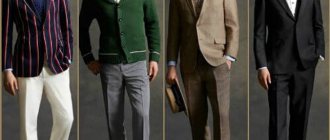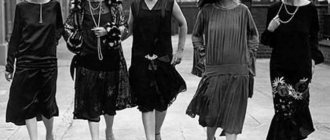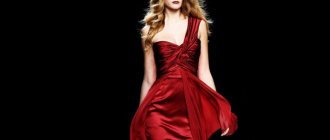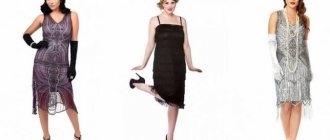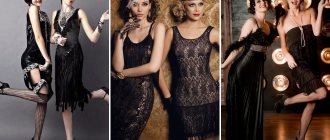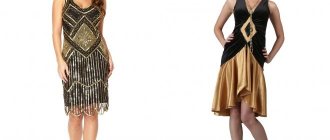The era of popularity of this fashion trend is a thing of the past, but individual decorative elements and a typical color palette are still used by many couturiers when creating modern collections. The disco style of clothing originated in the 80s of the last century. Imitating their musical idols, fashionistas of this era began to wear colorful, shiny, tight-fitting clothes and high hairstyles that attracted everyone's attention. The groups ABBA, Bee Gees, Boney M and Diana Ross gave birth to a new fashion trend, which was quickly picked up by ordinary people and began to be used in everyday life. Curvy figures have gone out of fashion, and slender, athletic bodies have become the standard of beauty.
Style Features
The disco style of clothing is characterized by materials such as lycra, polyester, and shimmering lurex. The most suitable outfit is tight-fitting, sparkling, bright. The trend is neon colors such as lemon, light green, orange, crimson, as well as fabrics with a metallic effect. For girls of the eighties, tight knitted tops, miniskirts, minidresses, wide floor-length hemlines, short tight shorts, overalls, leggings, and safari-style dresses made of suede were popular.
Thanks to the disco style, a fashion for “unisex” clothing arose - from now on, men were allowed to wear bright, tight T-shirts, jersey shirts, tight trousers, and women were able to try on men’s shirts and overalls. Disco is characterized by catchy, noticeable accessories: huge earrings, many different bracelets worn at the same time, several chains around the neck, large rings, colored sunglasses.
Shoes must certainly match all other details of clothing. For women, sandals, shoes, boots with high heels or platforms are best, and for summer - bright sandals with many decorative elements. Colored tights, often with lurex, have moved from the kitsch category to trendy accessories. Translucent tops and satin pants that hug the hips began to be worn by both girls and men.
Space
The science fiction craze brought fresh elements to disco fashion: shiny silver suits, dresses and shoes. Metallic is coming into fashion - the color of spacesuits and spaceships [4]!
Silver and gold dresses, jackets, shorts, tops, shoes, umbrellas and boots appear, and even metallic shadows in cosmetics! Space fashion showed itself especially clearly in the costumes of the artists - in those days they all seemed to have stepped out of the pages of comic books, dressing up as astronauts, aliens and superheroes!
Another “space” innovation: overalls. They were tight from hip to knee and flared from the knee. The sleeves also flared, although they might not have existed.
How to create a look depending on gender
Low-waisted jeans with flared legs were a must-have element in both men's and women's wardrobes. They were worn not only to discos, but also in everyday life; the style was complemented with bead embroidery and sequins. In the cool season, jeans were combined with tight turtlenecks. Men's shirts were also worn by both sexes. A fitted silhouette and a few undone top buttons were considered de rigueur. Such clothes fit well only on thin bodies, so fitness and diets came into fashion.
One or more items of clothing should be a bright, neon color, while the rest can remain almost neutral - white, black, silver-gray. The fashion trend for bright colors gave rise to another wave: not only clothes in the disco style, hair also began to shimmer in all sorts of shades: from crimson to blue or orange. This became possible after the advent of sprays with a short coloring effect.
For women
One of the most popular outfits, which was most often seen on the dance floor and terrified fans of strict classics, was a combination of bright leggings, short shorts and a tight top. No less popular were denim sundresses and bright trousers that fit the hips but were loose from the knees. Going to a disco was the most common entertainment for young people, and fast, rhythmic dancing required a special approach to clothing.
The outfits had to be made of elastic materials so as not to restrict movement. The style of clothing for dancing was in many ways reminiscent of sportswear, for example, leggings made of shimmering fabric, wide elastic belts emphasizing the waist, wide T-shirts, often on one shoulder. Such outfits were worn not only in clubs or gyms, but also in everyday life.
Although unisex clothing was incredibly popular, many women still preferred more sophisticated outfits. Mini skirts or A-line mini dresses that barely cover the hips have become incredibly popular. The materials were cotton, linen, wool, denim, suede. The clothes for the disco and club were especially bright and shiny.
For men
The ideal of male beauty was considered to be a tall, athletic young man with a thin body constitution. The image of John Travolta from the film “Saturday Night Fever,” which was released in the late 70s, became a standard for men. A typical outfit for a fashionista of this era:
- Snow-white suit;
- Knee flare;
- Men's dark shirt with unbuttoned buttons and a turn-down collar.
To make the look more simple and casual, the shirt could be replaced by a tight turtleneck. The disco style of clothing played an important role in the development of modern men's fashion. With the advent of disco, outfits for men became more relaxed and less formal. From now on it became clear that even in a suit you can look relaxed, free, and easy. The silhouette of the jackets acquired smoother lines and wider shoulders with shoulder pads.
At the beginning of the 80s, the young designer Giorgio Armani created a collection of silver-gray men's suits, satin shirts, and unusually loose ties. The creation was a dizzying success in America and Europe, thanks to which Armani instantly became famous. Men's suits did not try to look restrained:
- Jackets were complemented with flared jeans;
- Strict business attire - colored silk ties;
- Bright silk shirts were worn with calmer items.
Scenery
The Disco era is the mid-70s, when simple club music became incredibly popular. And the 80s, when there were few disco performers left, but what stars they were! And the first half of the 90s, when reckless catchy melodies again turned the heads of humanity. And even today, popular singers include individual disco-style compositions in their albums. What are we talking about?
There is no need to fanatically recreate the “spirit of that time.” Disco exists outside of time, and the desired atmosphere is the absence of inappropriate details. Therefore, a spacious empty hall (or room) that needs to be decorated with an extravaganza of color is ideal. Any bright, rich and contrasting shades are suitable - orange and purple, red and turquoise, chicken yellow and salad green!
A postcard in the shape of a vinyl record, a star or a triangle, decorated with sparkles and rhinestones - an invitation for friends is ready! Or cut out a disco dancer wearing a huge wig and a suit with flared sleeves and legs from a folded piece of paper.
The most important thing is color music. If your company has an electrician, he will assemble it in 15 minutes from a cord and painted lamps. You can use multi-colored shimmering garlands, large and round or in the form of candles, stars, diamonds. A constant rotating lamp for color madness, or better yet several. A disco ball, which can be rented or made from pieces of a mirror and an unnecessary globe (pasted and hung in the center of the room, under the ceiling). If one of your friends has a home planetarium, be sure to borrow it.
Boring walls can be covered with white paper wallpaper, chaotically painted - multi-colored stripes, splashes, spots, stains. A little reflective or luminescent paint will create a stunning effect!
Photos of popular performers from a bygone era will fit into the disco theme. Compositions by Van McCoy, Donna Summer, ABBA, Boney M, Chic, Gloria Gaynor and other groups and performers are the same music for competitions and, of course, for endless dancing. You can use photos, frames and melodies from the films “Disco Dancer”, “The Last Days of Disco”.
The disco boom in the USSR happened in the early 80s. From any cassette recorder and from every huge speaker in the disco hall came the compositions of VIA “Blue Bird”, “Singing Hearts”, “Gems”, Dobrynin, Pugacheva, Zatsepin, Antonov. Photos of our performers and their albums will also fit into the theme.
Now spice up the resulting decor with sparkles, serpentine, shiny foil garlands, strings of beads and twinkling stars. Hang vinyl records here and there, place a few “lava” lamps in the darkest corners - you're done!
We place accents with accessories
Women's disco clothing is characterized by several iconic accessories. First of all, these are massive earrings made of simple, non-precious materials. They were often worn in combination with colorful clothing or regular casual suits to add personality to the outfit. Another important element is an elastic hair band. It was often worn not only to remove hair from the forehead, but also as an additional decoration. Typically, such a ribbon was made of the same material as the main outfit, or another fabric similar in color and texture.
A popular summer accessory is a set of many thin bracelets made of silver or gold material, with a variety of notches and neat patterns. They were worn all at once so that the thin metal shimmered and clinked as they walked. Also during this period, large, colored plastic rings became fashionable.
Shoes
Thin high heels are beautiful, visually lengthen the legs and emphasize their slimness. But do not forget that you will have to dance a lot, and your feet will quickly get tired in heels. Choose equally interesting, but more convenient models. Shoes with stable heels or wedges are perfect.
Even the most beloved shoes become unusable over time. Make sure that there are no scuffs or cracks on the shoes. Clean and comfortable shoes should be the most important thing .
Hair and makeup
Looking at the photos of the 80s, it becomes clear that modesty and restraint were not in fashion. Incredibly bright, catchy makeup was at the peak of popularity, and natural, natural colors remained unclaimed for a long time. Girls of that era preferred shades of purple, light blue, blue, green, and boldly combined them with crimson or orange lipstick, coral blush, and colored mascara. Nails were painted in the same rich colors, and the shades of manicure and makeup could be any; color harmony was considered optional.
The basis of the style was a game of contrasts. Combinations of several colors in clothing, accessories, and makeup were the norm. The girls boldly combined orange trousers with a green tunic and complemented their look with makeup in lilac tones. Accessories could match the outfit in color and texture, but could be completely discordant with the overall look. Both women's and men's hairstyles were distinguished by incredible volume. To achieve the desired effect, fashionistas preferred to backcomb their hair and then fix their hair with hairspray.
Popular music and disco in the 1980s gave rise to unusual trends that influenced the further development of fashion in general. Tight-fitting, bright, shiny outfits have become available for both women and men. The harmony of colors also could not be observed, so nothing interfered with the flight of fancy of designers and fashionistas.
Halston dresses
Popular clothes for girls were long dresses (halston dresses), the idea of which belonged to fashion designer Roy Halston, known for his dislike of unnecessary non-functional details. His dresses had no fasteners, zippers, buttons or bows - the top of the dress (halter top) resembled a noose that went around the neck.
Almost all disco divas, including Donna Summer, Gloria Gaynor and soloists Boney M., did not ignore Halston’s dresses! Despite the apparent simplicity and asceticism, they hugged the body very sexy, emphasizing its shape. The absence of a bra under the dress was not only not hidden, but was also emphasized in every possible way by a deep neckline that reached almost to the panties, however, they were not always worn under it...
In everyday use there were denim maxi skirts, as well as sundresses with straps (another Halston invention), combined with T-shirts in loud shades and colors. It is becoming fashionable to put photo prints on T-shirts, especially with the names of musicians or rock bands (band t-shirts).
The attributes of almost all types of clothing were sparkles or sequins - pieces of gold that sparkled beautifully in the disco lights. In addition to clothes, they decorated hair and even the face!
Photo
Sport
The manic desire to lose excess weight in order to fit fashionable parameters leads to a surge in the popularity of aerobics and shaping, which are practiced by both men and women. Gyms bring new elements to disco fashion that would only fully emerge in the 80s: bandanas, brightly colored shorts, sneakers and tracksuits, as well as spandex, leggings and aerobics suits.
Roller skates were an important element of the disco era. Unlike modern ones (roller-bladers), the wheels were placed in pairs (roller-skaters). In the late 70s, even special discos for roller skaters appeared - a mixture of a club and a skating rink [3].
